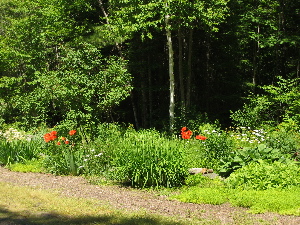OCTOBERYou can still plant spring bulbs.
Scatter a slow-release fertilizer (formulated especially for bulbs) on top of the soil after planting the bulbs. Remember to scatter this fertilizer over other beds of bulbs as well.
If you have gladiolus, this is the time to dig the corms up.
This is a wonderful time to fertilize both lawn and garden
Plant cool and warm-season lawns
Move worm bins to basement or garage to maintain at least 40* through the winter months
Divide a clump of chives and bring indoors
If you haven't lifted your dahlias yet, this would be the time!
Bring any plants that are growing in containers inside for the
winter. If they are hardy enough to remain outside all winter, tip the pots on their sides so any accumulated water will drain out. Although they should be able to stand the temperatures, ice can definitely be a problem!
Be sure to bring clay pots inside so they don't freeze causing cracking.
Reduce feeding houseplants(do not feed dormant houseplants)
Start a dish of paperwhites, and if you want a winterlong indoor display, plant a few more every other week.
Give your compost pile a final turning.
Try to keep the fallen leaves raked off the lawn. Put them in
the compost, shredding them first if possible, or mix them really well as they tend to compact.
Be sure that you have removed any foliage from your Iris plants. This foliage, if not discarded, can harbor Iris Borers over the winter. You surely don't want to see them in the spring!
You can plant garlic now for next years harvest. It's the perfect time to order and plant them so they have time to begin growing roots before winter sets in.
Mark any perennials you want to separate so you can find them
next spring.
Clean and oil your tools so they won't rust over the winter.
Plant container and balled-and-burlapped trees, fruit trees, shrubs and vines.
Put some rodent protection around the trunks of new trees. This can be in the form of hardware cloth or other substances you can get in the garden center or hardware store. This will protect the trunks from damage over the winter from hungry little critters.
Other trees can also be planted now.
Keep watering the shrubs and evergreens.
Plant container roses and prune your hybrid tea roses. Start preparing your roses for winter. They should be mulched when the ground begins to freeze.
If your roses had signs of black spot or other foliage diseases you should remove the the leaves so it doesn't recur again next year. Once a hard freeze has beaten down your garden, remove the leaves from the affected roses, as well as any mulch that might have remnants of those infected leaves, and throw it into the garbage (NOT the compost-you do not want to spread it throughout the garden next year). Bite the bullet and add new winter mulch.
Cut back your perennials and put the foliage in the compost as long is it's not diseased. If there is green at the base, leave about 4-5 inches of leaves.
Try to leave about 4 inches of stem on the lilies you cut back. In the spring, they appear rather late. By leaving some of the stem, you'll know where they are hiding in the garden!
Leave the ornamental grasses. They look quite attractive in the winter garden.
Sow seeds for frost-tolerant perennials
Try using evergreen boughs over your shrubs to provide winter
protection. They can be forced into the ground before the ground freezes, draping their branches over the shrubs.
You can of course, also protect evergreens with burlap barriers. Do NOT use plastic!
Pull out your annuals and put them in the compost
It's time to store your hoses inside. Remember to drain them first
so they don't freeze and split!
Bring in any annual geraniums! Potted, in a sunny spot they will bloom all winter. Or hang them upside down (with the dirt removed) in a cool spot like the garage, or basement.
Get those bird feeders up! Be sure you have cleaned them first!




